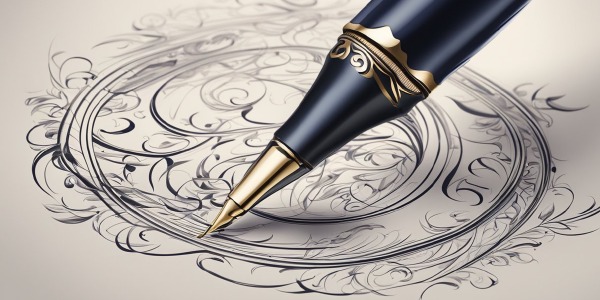The Top 5 Tips for Improving Your Writing Skills: Essential Strategies for Better Expression
Improving writing skills is a common goal for many. Whether you’re a student looking to excel in your essays, a professional aiming to craft better reports, or a creative writer aspiring to captivate your audience, strong writing capabilities are an invaluable tool across various aspects of life. Engaging written content has the power not only to convey information but also to influence and inspire readers.

Writing is an art that requires a blend of creativity and technical prowess. Like any skill, it can be honed with practice and the right techniques. It involves understanding the basics of grammar and style, organizing thoughts in a coherent structure, and refining your work through revision. But improvement also transcends the pages; it includes applying these enhanced skills to various real-world contexts, where the clarity and impact of your communication can contribute significantly to your success.
Key Takeaways
- Strengthening writing skills enhances clarity and effectiveness in communication.
- Regular practice and learning writing fundamentals contribute to developing proficiency.
- Better writing influences various real-world applications, benefiting personal and professional growth.
Understanding the Basics of Writing

Mastering writing involves a strong grasp of English grammar, punctuation, and sentence construction. Careful word choice ensures clarity and impact in your paragraphs and overall message.
Grasping Grammar and Punctuation
Understanding grammar is fundamental to writing well. You should know your subject-verb agreements, tenses, and the function of different parts of speech. Proper punctuation is equally important; it aids in the flow and clarity of your sentences. Here’s a basic checklist to guide you:
- Subjects and Verbs: Ensure they agree in number (singular/plural).
- Tenses: Use the correct tense to convey the time of action consistently throughout your piece.
- Commas and Periods: Use commas to separate clauses, and periods to end declarative sentences.
Structuring Sentences and Paragraphs
Your sentences and paragraphs serve as the building blocks of your writing. Each sentence should follow a clear structure (subject, verb, object) and vary in length to maintain the reader’s interest. Paragraphs should contain one main idea and a few supporting sentences. Keep these tips in mind:
- Sentence Length: Mix short and long sentences to create a rhythm.
- Paragraph Unity: Start with a topic sentence and follow with supporting details.
- Cohesion: Use transitional words to connect sentences within a paragraph.
Choosing the Right Vocabulary
Selecting the right words is crucial for effective communication. Opt for simple words that precisely express your thoughts to ensure understanding. Be mindful of connotations and choose words that fit the context. Here’s a simple approach:
- Word Choice: Prefer simple words over complex ones to maintain clarity.
- Appropriate Language: Tailor your vocabulary to your intended audience and purpose.
- Synonyms: Use them sparingly to avoid repetition and keep your reader engaged.
Understanding these basics sets the groundwork for your growth as a writer.
Designing Your Document

Effective document design helps you organize your thoughts and guides your readers through your text seamlessly. This involves structuring your document with a strong foundation, which encompasses creating a comprehensive outline, forming cogent arguments, and crafting engaging content from the start to the end.
Crafting an Effective Outline
Before you dive into writing, create an outline to map out your document’s flow. Your outline should include:
- Title: A clear and concise heading that encapsulates your document’s essence.
- Introduction: A preview of what’s to come, setting the tone for your readers.
- Body Paragraphs: Bullet points or numbered lists that represent each section’s main idea.
- Conclusion: A summary that reinforces your main points and leaves a lasting impression.
Remember, an outline serves as a skeleton that will support the rest of your content.
Building Strong Arguments
Your arguments form the core of your document. To build strong arguments, ensure that:
- Each argument has a clear main idea.
- Support each main idea with facts, statistics, or quotes for validity.
- Align your arguments logically to build momentum in your narrative.
It’s essential that your body paragraphs house your arguments effectively, drawing the reader to a logical and well-founded understanding of your position.
Writing Engaging Introductions and Conclusions
The introduction and conclusion are your first and last chance to engage your readers. For a compelling introduction:
- Begin with a hook: a question, statistic, or a bold statement to grab attention.
- Provide context to inform the reader about your document’s objective.
A powerful conclusion should:
- Echo the main ideas, without merely repeating them, to reinforce your message.
- End with a call to action or a thought-provoking statement to inspire further reflection or action.
Enhancing Your Writing Style

Your writing style significantly affects how your content is received. These specific techniques can make your prose clearer and more engaging.
Employing the Active Voice
Using the active voice makes your sentences clearer and more direct. Here’s how you can recognize the active voice:
Subject performing the action: Ensure the subject of your sentence performs the verb’s action.
Example Table:
Passive Voice Active Voice The book was read by the student. The student read the book. The meeting will be led by Sam. Sam will lead the meeting.
Employing the active voice often results in shorter sentences that are easier to understand.
Trimming Filler Words and Adverbs
Excessive use of filler words and adverbs can weaken your writing. Here’s a strategy for tightening your prose:
- Identify and remove unnecessary words that don’t add meaning to the sentence.
- Minimize adverbs that can be replaced with strong, specific verbs.
- Before: She ran really quickly to catch the bus.
- After: She sprinted to catch the bus.
Writing Concise and Short Sentences
Concise sentences improve readability. To write concisely:
- Aim to convey your idea in as few words as possible without losing meaning.
- Break up long, complex sentences into shorter ones to enhance understanding.
Revising and Perfecting Your Work

Crafting a well-written piece requires diligence in revising and perfecting your work. This ensures every sentence serves its purpose, the flow is coherent, and the spelling and grammar are immaculate.
Editing for Clarity and Flow
To enhance clarity and ensure smooth flow, read your draft aloud. This practice allows you to spot awkward phrases and convoluted language that may confuse readers. Organize your content in a logical sequence, utilizing formatting tools like:
- Bullet lists to present multiple points concisely
- Italics or bold to emphasize key terms
- Short paragraphs to maintain reader engagement
Clarity directly affects how effectively your message reaches the audience, guiding you to refine each sentence for maximum impact.
The Importance of Proofreading
Proofreading is vital to catch errors in spelling, grammar, and punctuation that automated tools might miss. Pay special attention to:
- Homophones (e.g., “they’re” vs. “their”)
- Consistency in tense and perspective
- Correct use of punctuation
Consistent checks bolster your credibility and demonstrate attention to detail, contributing to your progress as a writer.
Receiving and Implementing Feedback
Embrace feedback from others, as it can offer new perspectives and highlight areas you might have overlooked. Consider the following when reviewing feedback:
- Is the critique constructive and aimed at specific aspects?
- How can it enhance the clarity and flow of your work?
Balance the feedback with your personal style to maintain your voice while making the necessary adjustments. This iterative process is a key factor in your evolution and progress in writing skills.
Applying Writing Skills in Real-World Contexts

Mastering your writing skills has profound implications in various real-world scenarios. Excelling at crafting documents, from emails to cover letters, can influence your professional trajectory, enhance your communication, and elevate the quality of your content.
Professional Communication: Email and Reports
In professional settings, your ability to convey ideas through email and reports is vital.
For emails, focus on a clear subject line and start with a polite greeting.
Use bullet points to make key information accessible, ensuring a concise but informative tone.
When writing reports, structure is crucial; start with an executive summary, then present the background, followed by findings and conclusions.
Detail is important, but always aim for clarity and brevity.
Email Example:
- Subject: Meeting Recap & Next Steps
- Greeting: Dear [Recipient’s Name],
- Body: Bullet points of key takeaways and action items
Report Structure:
- Executive Summary: Brief overview of main points
- Background: Context and purpose
- Findings: Data or outcomes of your research
- Conclusions and Recommendations: Your assessments based on the findings
Crafting a Compelling Resume and Cover Letter
Your resume and cover letter are crucial tools in your job search. They highlight your qualifications and persuade employers to consider you as a candidate.
Ensure your resume is well-structured, with clear headings and bullet points showcasing your achievements and skills.
Tailor your cover letter to the job description, highlighting how your experience aligns with the role and expressing your enthusiasm for the position.
Resume Tips:
- Contact Information: At the top, clear and current
- Professional Experience: Use strong action verbs, quantify achievements
- Education & Certifications: Relevant academic and professional qualifications
Cover Letter Structure:
- Introduction: Engage the reader and state the job you’re applying for
- Body: Discuss your relevant experience and skills
- Closing: Reiterate your interest and thank the reader for considering you
Effective Copywriting and Presentations
Whether you’re creating promotional material or preparing for a public speaking event, the key to effective copywriting and powerful presentations is engagement.
For copywriting, understand your audience and craft a compelling message with a clear call to action.
In presentations, structure your content with an introduction, main points, and a strong conclusion.
Use visuals to reinforce your message, but don’t let them overshadow your content.
Copywriting Checklist:
- Headline: Captures attention and summarizes the content
- Body Copy: Provides value and maintains reader interest
- Call to Action: Clear and persuasive, encourages a response
Presentation Tips:
- Opening: Strong start to grab audience attention
- Structure: Logical flow of ideas
- Visual Aids: Support and enhance, not distract




